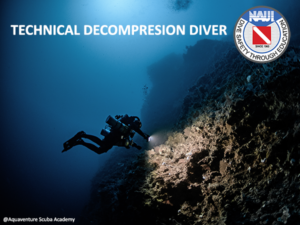Technical Decompression Diver
This course is to provide the diver with a working knowledge of the theory, methods, and procedures of planned staged decompression diving while using optimal breathing gas mixtures. As a part of the course students will plan and conduct standard staged decompression dives not exceeding a maximum depth of 46m (150 ft.) while using air, nitrox or helitrox if combined with that course. Equipment requirements, team requirements, NTEC configurations, decompression breathing gas mixtures (oxygen and EANx).
Upon successful completion of this course, graduates are considered competent to plan and execute dives that require staged decompression to a maximum depth of 46m (150 ft.) utilizing an optimal breathing gas as bottom gas and up to 100% oxygen for decompression without direct supervision provided the diving activities and the areas dived approximate those of training.

Get Started
Minimum age is 18 years of age and graduate from a NAUI Introduction to Technical Diving course or equivalent is required for all continuing NAUI Technical Diving courses. Additional training and experience requirements vary for each course. A qualified NAUI Instructor can evaluate your resume and answer questions about your readiness to pursue specific training.
What’s Next?
Continue your training by enrolling in a NAUI Trimix I Diver course.
COURSE DETAILS
Academic: E-learning/Classroom
Practical Application:
Open Water Dives: 6 dives
REQUIREMENTS – SKILLS
-
-
- Applied Sciences
- Review decompression theory
- Decompression tables
- Maladies associated with diving and increased risks of decompression diving
- Nitrogen narcosis
- Thermal aspects of technical diving
- Breathing gas calculations
- Psychological aspects of technical diving
- Technical Diving Equipment
- Selecting and configuring diving equipment for staged decompression
- NTEC
- Equipment configurations being used and alternative configurations they may encounter
- Decompression Procedures
- Conducting a decompression dive
- Oxygen breaks
- Decompression systems
- Methods (Drift, Line etc.)
- Equipment
- Safety
- Introduction to support team operations
- Dive Planning
- Utilize the ODIGTML Dive Planning format or address each of the elements in the ODIGTML format
- Oxygen
- Decompression
- Inert Gas Narcosis
- Gas Management
- Thermal
- Mission
- Logistics
-
-
- Breathing gas analysis
- Predive equipment inspection
- Dive planning
- Safely execute each dive
- In addition to the completion of the Technical Diver Skills Checklist, in open water each student must demonstrate the ability to control and manipulate a stage cylinder while:
- Hovering horizontally with the proper body position.
- Rotating 360 degrees in a stationary horizontal position.
- Backing up for 2m (6 ft.).
- Staging and recovering a stage cylinder without the loss of environmentally appropriate buoyancy control or trim.
- When simulated or actual planned decompression stops are conducted, divers will demonstrate stops with the use of an upline and surface marker.
- Contingency dive planning and problem solving situations are to include omitted decompression, altered bottom time profile with increased or decreased decompression requirement and recalculation, loss of ascent equipment, i.e., surface marker and reel, stage cylinders, ascent line, loss of decompression breathing gas, and decompression gas supplied by dive partner or surface support.
- Each diver is to demonstrate switching and isolating a malfunctioning regulator, first in confined water, and following adequate practice, in open water at a depth between 4.5m and 10m (15-33 feet).
- Each diver is to demonstrate underwater navigation appropriate to the dive plan. On at least two of the required dives, students are to ascend with ascent reel and surface marker and perform necessary or simulated staged decompression.
- Students shall participate in a diver rescue simulation to include
- Management of a diver experiencing oxygen toxicity underwater
- Students shall participate in a lost/failed upline/surface marker drill
PREREQUISITES
- Age. Minimum is 18 years by the water phase of the course.
- Certification/Experience/Knowledge.
- NAUI Master Scuba Diver or equivalent.
- NAUI Introduction to Technical Diving or equivalent.
- Proof of at least 50 logged dives with 15 logged dives on EANx.
- The instructor is to ensure adequate student knowledge and capability before any open water training and shall use skill or other evaluations to do so. One open water dive (which does not count toward the minimum number of dives required for the course) may be used as a screening and evaluation dive. This is not required when the student’s diving proficiencies are well known to the instructor.





